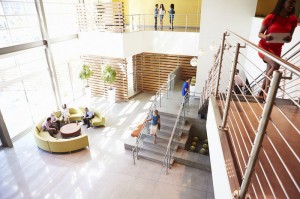Offices and commercial buildings use about one-fifth of America’s nationwide energy production. Designing an eco-friendly office that takes into account energy efficiency should both reduce its environmental impact and improve the business’s bottom line over time. Eco-friendly office design includes a combination of location, equipment, building features and usage. Adopt energy-saving practices to make the smartest use of efficient equipment.
Five Tips to Making Your Eco-Friendly Office
Start from the top. If you’re designing a new building, assess the feasibility of installing a “green roof.” Green roofs cover the top of a building with a living layer of plants, grass or other vegetation that acts as an insulator. Green roofs moderate excessive outdoor heat in the summer and help retain heat inside the building during the winter. Green roofs cost more to install, but by reducing building energy use they can recoup their cost and even become profitable over their lifetime, depending on the building and climate (see References 1).
Implement smart climate control. Use programmable thermostats to let managers and employees control temperature settings both by time of day and room-by-room. Turn off, or reduce, climate control in unused spaces such as empty conference rooms or vacant offices, and program your climate control system to turn itself down at night and at other times when the office is empty (see References 2). When installing new climate control equipment, such as furnaces and air conditioners, purchase systems with the U.S. Environmental Protection Agency’s Energy Star certification.
Use energy-saving computers. Start with new computers bearing the Energy Star label. Then set them to operate as efficiently as possible. Using power-management options in the operating system software, set monitors to turn off after periods of inactivity, and set desktop systems to “sleep” or hibernate at the end of the day and when employees are out. The EPA estimates that smart power management alone can save more than $75 per computer each year.
Install efficient windows and shades. Modern, efficient windows work to block outdoor heat from entering buildings in the summer, while retaining heat inside buildings during the winter. Window energy characteristics are described by a number of variables (see References 4), so do research or consult with an expert to determine the smartest mix of window features for your climate and needs. South-facing windows generally admit the most exterior heat. Use shades to adjust light and heat entry throughout the workday (see References 5). Remember that different locations in an office may benefit from different types of windows.
Install smart lighting. Automated systems including timers, motion detectors and photosensors can activate lighting as needed throughout the workday, while turning lights off when unneeded and when rooms are empty (see References 6). For lighting fixtures, fluorescent bulbs use less energy than standard incandescents. Use natural daylight to your advantage; window-equipped offices can reduce their reliance on artificial lighting during daytime hours.
Get In Touch With Glover Furniture And Design Group Today
When you’re ready to create your eco-friendly office, think of us. We are a woman-operated business supplying the Delmarva region, including Washington, D.C., and Pennsylvania, with educational, institutional and commercial furniture. Stay with our blog for weekly posts! For more information, contact us today at 1-800-966-9016 or 410-771-8000. Don’t forget to connect with us on social media with Facebook, Twitter, Google+, andPinterest for more updates and information.

